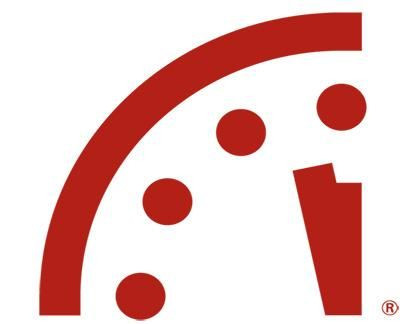Doomsday Clock Update: Year-By-Year Timeline From Bulletin Of The Atomic Scientists

Increasing tensions with North Korea and the U.S., a long-running investigation into Russia’s efforts to interfere in the election, climate change and more aren’t just things dominating your news feed. According to the Bulletin of the Atomic Scientists, those issues are pushing closer to doomsday.
As of Thursday the Doomsday Clock is now 2 minute to midnight. But why?
“In 2017, world leaders failed to respond effectively to the looming threats of nuclear war and climate change, making the world security situation more dangerous than it was a year ago—and as dangerous as it has been since World War II,” the group said. “The greatest risks last year arose in the nuclear realm. North Korea’s nuclear weapons program appeared to make remarkable progress in 2017, increasing risks for itself, other countries in the region, and the United States. Hyperbolic rhetoric and provocative actions on both sides have increased the possibility of nuclear war by accident or miscalculation …. On the climate change front, the danger may seem less immediate, but avoiding catastrophic temperature increases in the long run requires urgent attention now …. The nations of the world will have to significantly decrease their greenhouse gas emissions to keep climate risks manageable, and so far, the global response has fallen far short of meeting this challenge.”
With the Doomsday Clock updating in 2018 to two minutes until midnight, let's take a look back at a year-by-year list of what the Doomsday Clock was. The Bulletin was founded in 1945 and the Doomsday Clock is updated depending on current events.
Doomsday Clock Timeline:
1947 : 7 minutes until midnight.
1949: 3 minutes until midnight. (President Harry Truman tells public Soviets tested their first nuclear device.)
1953: 2 minutes until midnight: “After much debate, the United States decides to pursue the hydrogen bomb, a weapon far more powerful than any atomic bomb,” the Bulletin writes.
1960: 7 minutes to midnight.
1963: 12 minutes to midnight. (U.S. and Soviet Union sign the Partial Test Ban Treaty, which effectively ends nuclear testing.)
1968: 7 minutes to midnight.
1969: 10 minutes to midnight.
1972: 12 minutes to midnight. “The United States and Soviet Union attempt to curb the race for nuclear superiority by signing the Strategic Arms Limitation Treaty (SALT) and the Anti-Ballistic Missile (ABM) Treaty,” the group wrote.
1974: 9 minutes to midnight.
1980: 7 minutes to midnight.
1981: 4 minutes to midnight.
1984: 3 minutes to midnight. “U.S.-Soviet relations reach their iciest point in decades,” the Bulletin writes.
1988: 6 minutes to midnight.
1990: 10 minutes until midnight
1991: 17 minutes until midnight. (Cold War ends.)
1995: 14 minutes to midnight
1998: 9 minutes to midnight
2002: 7 minutes to midnight. (Aftermath of 9/11 felt worldwide, calls for war begin.)
2007: 5 minutes to midnight.
2010: 6 minutes to midnight. “Talks between Washington and Moscow for a follow-on agreement to the Strategic Arms Reduction Treaty are nearly complete, and more negotiations for further reductions in the U.S. and Russian nuclear arsenal are already planned. The dangers posed by climate change are growing, but there are pockets of progres,” the Bulletin wrote.
2012: 5 minutes until midnight.
2015: 3 minutes to midnight. “Unchecked climate change, global nuclear weapons modernizations, and outsized nuclear weapons arsenals pose extraordinary and undeniable threats to the continued existence of humanity, and world leaders have failed to act,” the Bulletin wrote.
2016: 3 minutes to midnight.
2017: 2 minutes to midnight.
While the Doomsday Clock update is scary, the Bulletin of the Atomic Scientists said they aren’t trying to make a prediction.
“... we study events that have already occurred and existing trends. Our Science and Security Board tracks numbers and statistics—looking, for example, at the number and kinds of nuclear weapons in the world, the parts per million of carbon dioxide in the atmosphere, the degree of acidity in our oceans, and the rate of sea level rise,” Kennette Benedict, senior advisor to the Bulletin of the Atomic Scientists, wrote. “The board also takes account of leaders’ and citizens’ efforts to reduce dangers, and efforts by institutions—whether of governments, markets, or civil society organizations—to follow through on negotiated agreements.

© Copyright IBTimes 2024. All rights reserved.





















